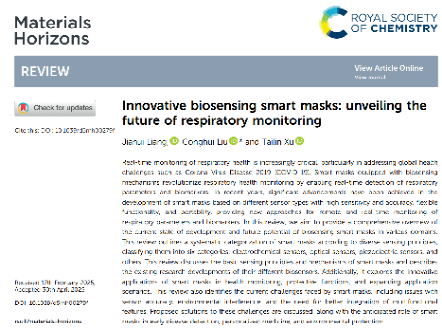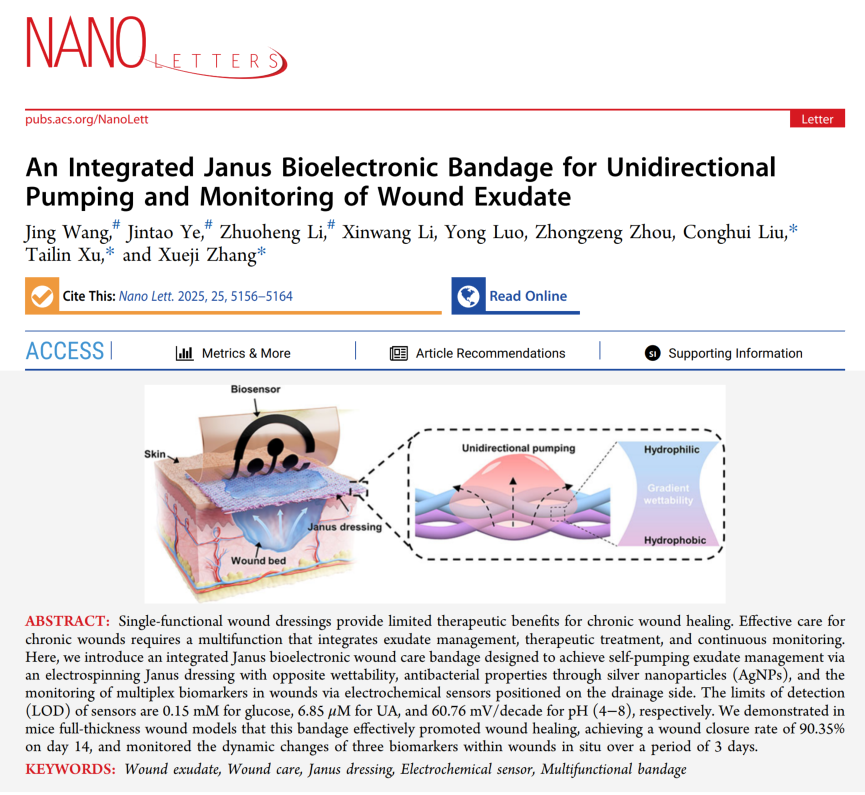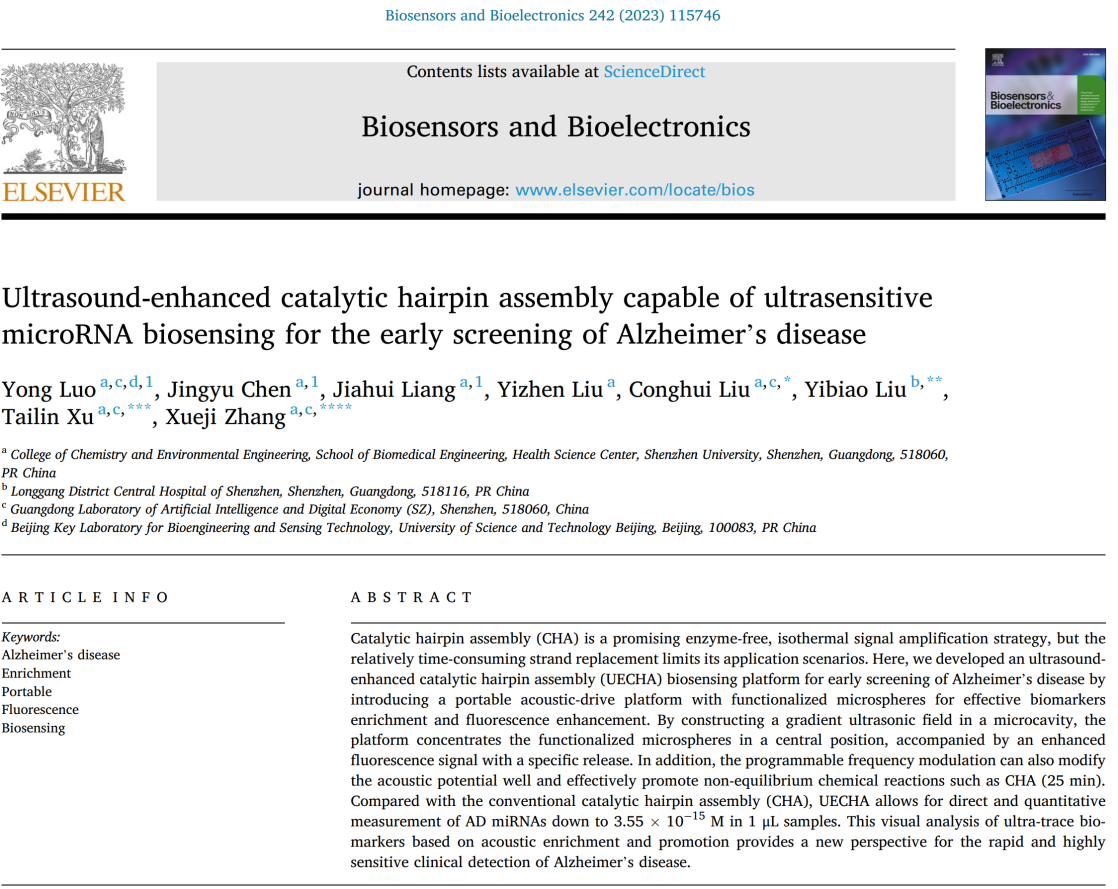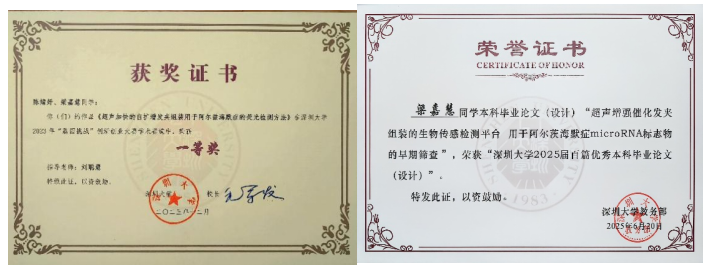Recently, undergraduate students majoring in Chemistry from Shenzhen University have published three papers as first authors in internationally renowned academic journals. The specific information is as follows:
1. The paper "Innovative Biosensing Smart Masks: Unveiling the Future of Respiratory Monitoring" written by Jiahui Liang, an undergraduate student majoring in Chemistry from the 21st grade of our university, as the first author, has been published in the internationally renowned academic journal Materials Horizons (IF 10.7). The corresponding author is Assistant Professor Conghui Liu. This paper has received support from the Shenzhen Medical Research Fund and the Guangdong University Student Science and Technology Innovation Cultivation Special Fund Support Project.
The article summarizes the diversity and integration strategies of intelligent sensing materials, and proposes various performance improvement approaches, including self-powered energy systems, flexible wearable structure optimization, and the combination of artificial intelligence analysis algorithms, providing valuable research ideas for promoting the industrialization and clinical transformation of intelligent wearable medical devices.

Original link: https://pubs.rsc.org/en/content/articlelanding/2025/mh/d5mh00279f
2. The paper "An Integrated Janus Bioelectronic Bandage for Unidirectional Pumping and Monitoring of Wound Exudate" written by Jing Wang, a doctoral student majoring in Chemistry, Jintao Ye, an undergraduate student majoring in Chemistry Education, and Zhuoheng Li, an undergraduate student majoring in Chemistry, as co-first authors, was published in the Nature Index journal Nano Letters. This study received support from the Innovation and Entrepreneurship Project for College Students and was awarded an excellent completion.
The article constructed a hydrophobic TPU nanofiber layer loaded with silver nanoparticles on the surface of hydrophilic medical gauze using electrospinning technology, achieving efficient unidirectional transport of wound exudate from the hydrophobic side to the hydrophilic side and excellent antibacterial performance; Further integrate electrochemical sensors to monitor various biomarkers (glucose, uric acid, pH) in wounds. The Janus bioelectronic bandage demonstrated significant pro healing effects in a mouse model of full-thickness skin defects, with a wound closure rate of 90.35%.

Original link: https://pubs.acs.org/doi/10.1021/acs.nanolett.4c06147
3. Luo Yong, a joint PhD student between Shenzhen University and University of Science and Technology Bejing, Jiahui Liang and Jingyu Chen, undergraduate students majoring in Chemistry, published a research paper titled "Ultrasound-enhanced catalytic hairpin assembly capacity of ultra sensitive microRNA biosensing for the early screening of Alzheimer's disease" as co-first authors in the top journal Biosensors and Bioelectronics. This study was supported by the Guangdong University Student Science and Technology Innovation Cultivation Special Fund Support Project, and was awarded the Excellent Completion of the Shenzhen University Student Innovation and Entrepreneurship Training Program (Provincial Level), the First Prize in the Academic Track of the Shenzhen University 2023 Innovation and Entrepreneurship Competition, and the Top 100 Outstanding Undergraduate Graduation Theses (Designs) of Shenzhen University 2025. Jiahui Liang and Jingyu Chen, undergraduate students majoring in Chemistry in the 21st grade, have both obtained honorary bachelor's degrees from the college and obtained direct doctoral qualifications from Shenzhen University and Xihu University, respectively.
The article developed a low-cost, rapid response, and low serum volume consumption (approximately 1 μL) miRNA detection method. This method relies on ultrasound to promote the self-assembly of catalytic hairpins and the integrated driving platform for acoustic enrichment of probe modified functionalized microspheres, achieving cascade signal amplification, which is expected to become a powerful tool for preliminary screening of AD.


Original link: https://www.sciencedirect.com/science/article/pii/S0956566323006887?via%3Dihub
